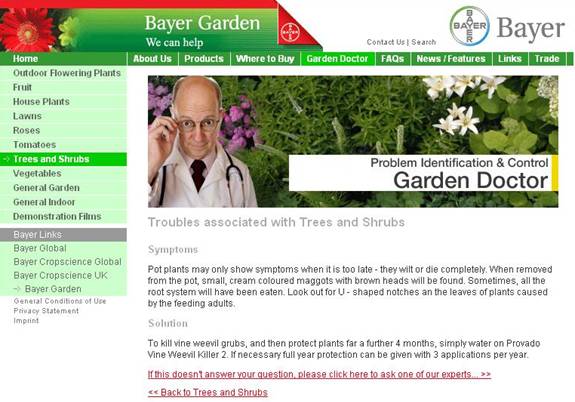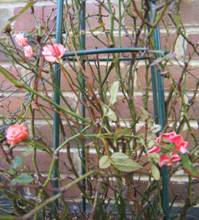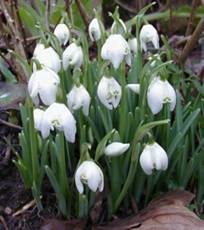| |
Foreword, 07.02.10
In laboratory conditions the product may perform, and this would have led to its apparent licensing for containers. Based on what I learned, the product may be suited for industrial application in nurseries. But I am not sure whether it was suitable for domestic use, and to be released into the environment. In the very least, I believe that the labeling and the marketing of this product should further change. The article was shown on dagmar.org.uk since the evening of 07.09.2005, after the manufacturer raised no objections to its publication; the current edited version was uploaded 22.02.2010 after the manufacturer showed no interest in the matter.
dagmar.org.uk
Provado Vine Weevil Killer 2 -
Another Environmental Damage in the Making?
 After WWII, DDT was hailed as an entirely harmless saviour of humanity from parasites. Its extensive application soaked through the soil which it contaminated, and it was subsequently washed into the sea beds which it poisoned. DDT was banned. At the time of the Gulf War organophosphates were still in use for animals and humans. The devastating effect that this deadly poison had on the Gulf War veterans, and which was initially denied, was shocking. Organophosphates were banned, but not before they caused many deaths and suffering. The repeated release of deadly poisons into the environment which are subsequently banned following a disaster, or a tragedy, seriously raises the question of the credibility of the testing and licensing procedures that may have been involved. Expectations of millions in profits possibly drive some manufacturers to market insufficiently tested products. But how could the mistake involving the organophosphates take place after the lessons from the DDT? The Provado Vine Weevil Killer 2 case suggests that a potent toxic chemical leaving toxic residue within the soil may be launched, with or without limitations on the recommended use, without a proper investigation into its longer term effects. Provado had been advertising the product heavily, and whilst making claims which the product did not appear to live up to, when I tested in my containers and in the garden. After WWII, DDT was hailed as an entirely harmless saviour of humanity from parasites. Its extensive application soaked through the soil which it contaminated, and it was subsequently washed into the sea beds which it poisoned. DDT was banned. At the time of the Gulf War organophosphates were still in use for animals and humans. The devastating effect that this deadly poison had on the Gulf War veterans, and which was initially denied, was shocking. Organophosphates were banned, but not before they caused many deaths and suffering. The repeated release of deadly poisons into the environment which are subsequently banned following a disaster, or a tragedy, seriously raises the question of the credibility of the testing and licensing procedures that may have been involved. Expectations of millions in profits possibly drive some manufacturers to market insufficiently tested products. But how could the mistake involving the organophosphates take place after the lessons from the DDT? The Provado Vine Weevil Killer 2 case suggests that a potent toxic chemical leaving toxic residue within the soil may be launched, with or without limitations on the recommended use, without a proper investigation into its longer term effects. Provado had been advertising the product heavily, and whilst making claims which the product did not appear to live up to, when I tested in my containers and in the garden.
This is what Provado claimed on their website in 2005:
"When you water your plants with Provado Vine Weevil Killer 2 it kills grubs in the soil on contact.", and "...the whole plant becomes a deadly banquet for pests." |
|
When I used the product as advised on my garden at the cost of £1,664, it failed on all of my ericaceous plants which were severely affected, it also failed on my privet hedge, it offered only a limited and a short lived support to my patio roses, and it failed to prevent the further spread of the Vine Weevil to the remaining plants. My privet hedge and several of my other plants were dying, but the Vine Weevil, whether perhaps even in some kind of a mutated form, appeared to have been thriving up until the introduction of the nematodes that actually started to make a difference. I continue searching for additional entirely natural forms of defenses against the menace. |
The outcome following an application of the Provado Vine Weevil Killer 2 appears to be fluctuating according to plant. After applying the same concentration the same number of times to my Bay Tree, as well as to the patio roses, the Bay Tree survived quite well but the roses did not, and no protection whatsoever appears to have been given to the Pieris varieties, or to a Laurel.
When I complained to Provado about the result, the suggestion was made that the product was not recommended for gardens, but for containers.
The screen below is from the manufacturer's website on 07.02.10. Note that it all seems about Gardens, and although pot plants are mentioned, there is no warning whatsoever against the use of the product on the garden, in fact, and as you can see, it is not the "pot plant doctor", but the "Garden Doctor" himself, who recommends the product, and he is talking about troubles with trees and shrubs! That was my predicament. I do not know how many gardeners grow their trees and shrubs in containers.

My entire garden is a self-contained corner plot and I treated it as a single large container, using the recommended concentration, and on larger trees taking into account their deeper roots. Not a square inch of soil was left out. I thought that by being thorough I would reduce the risk of cross contamination. I had a garden expert provided by Provado visiting following my complaint, and he calculated whilst on the premises, that the amount of the solution used would have been appropriate for the size of the garden and the number of plants.
Whilst the manufacturer recommended the Vine Weevil Killer 2 for the use in containers in 2005 and for ornamental plant containers by 2010 the first side effect that this thick and sticky pesticide appears to have is the waterloging of compost in the containers, after just one application. After I applied the solution in the exact concentration as recommended by the manufacturer, some of my containers only dried eventually by evaporation, by which time the stale water mixed with the pesticide appears to have killed several of my more fragile container grown flowering plants. Another disconcerting side effect showed within days after application. Many of my plants and trees started displaying general paling of leaves, with signs of degeneration, such as smaller and twisted leaves appearing on new growth. The foliage of some plants does not tolerate the solution at all. I inadvertently watered the lowest branches of my Picea Pungens Koster, and the foliage lost its typical silver finish immediately when touched by the Vine Weevil Killer 2, and it subsequently died off. Why was there not a warning on the bottle in relation to this plant, for example? I wrote to several organizations, including Defra and the Royal Horticultural Society.
On the website of the Royal Horticultural Society (visited 07.02.10), and whilst the product was mentioned as a possible chemical control for Vine Weevil, it had been stated that the product cannot be used to treat edible plants or ornamental plants growing in open soil.
The article did not give reasons or further reference. Why not?
After an initial indication that the product may work, third and subsequent applications seemed progressively less effective against the parasite.
In the time following the Vine Weevil treatment the garden seemed to coincidentally have become further beset by all kinds of other pest and diseases. May the treatment have possibly led to some kind of an imbalance in other beneficial properties or bacteria in the soil that may otherwise be helping the plants to be stronger in withstanding other forms of attack? In 2005 the manufacturer stated that they have not yet obtained a licence for recommending the product for the use on gardens.
What effects has possible further testing discovered this product to have on the gardens?
Why does the label not indicate a single reason why the product "cannot" be used on the garden?
Instead, it is recommended for pots, but whilst the product is marketed by the manufacturer via the "Garden Doctor" and for the use in relation to problems with shrubs and trees. (Refer to the screen of 07.02.10, above.)
What actual benefits does this product have for the containers as different from the garden, for the use of which it would have been licensed before wider testing on the gardens may have taken place? I noted the new packaging in 2010. It specifies that the product is for the use on "ornamental pot plants". This new wording seems to indicate that the recommended use of the VWk2 would have been reduced from (any) "pot plants" in 2005, to "ornamental pot plants" in 2010. What are the reasons why the product stopped being recommended for (any) pot plants? Why is it still sold at all?
More than four years on from my Provado Vine Weevil Killer 2 experience, and following more strenuous efforts to now recover the balance in my garden by adding natural fertilizers, bacteria, and beneficial insects, I am making only a slow progress.
I believe that my experience urgently called for a thorough long term research into the use of this pesticide. I am inclined to believe that the product is unsatisfactory and that it may even be dangerous to the environment. As Vine Weevil continues to spread, and it is becoming more common, if remaining on the market, and with the existing labeling,
the general use of this pesticide
could increase.
The important question that, I believe, emerges from my entire Vine Weevil experience in the long run is why is this pesticide at all considered necessary for the release to the general public? Nature may present the answer to the Vine Weevil, even if perhaps not with a single vine weevil killer, but possibly by harmoniously playing several naturally occurring deterrents together within the plants' natural environment.
There may be the nematodes, microscopic worms that feed on the Vine Weevil, and with seemingly not yet established possible negative side effects to the environment, albeit container grown fuchsias seem detrimentally affected. With the exception of the container grown fuchsias, after I applied a small pack of nematodes for the first time on a number of plants that appeared nearly dead, within three weeks, the result seemed almost spectacular in some cases, and it started showing within days from application.
I would like to hear from independent gardening experts. I would like to invite their opinions and possible recommendations in writing, because I believe that I may still be entitled to a redress from the manufacturer.
Upon my complaint in 2005 the manufacturer agreed to send out an independent gardening expert and provided three names for me to choose from. Mr. D. Gardner took many pictures of affected plants in my garden, and produced a
report the most prominent feature of which seemed a big red arrow pointing at a dead snail in a flower pot. He also included into the report some quite pretty looking general shots of my garden. Provado had not confirmed whether Mr. Gardner may have enquired about possible employment with the company at the occasion of his report, and the company seemingly refused to comment on any of the contents of Mr. Gardner's report in our subsequent correspondence.
DISCLAIMER:
I wrote this article in good faith and in the belief that it conveys the truth. It reproduces to the best of my knowledge and ability my experience with the Provado Vine Weevil Killer 2. I believe that I am making only true and substantiated remarks about the product, the manufacturer and the distributors. The manufacturer was in 2005 made aware of the complaint throughout, and several communications were exchanged with him prior to first publication in the evening of the 7th September 2005. Robert Smit, a representative of the manufacturer, confirmed that he had read the published article.
The manufacturer was further invited 08.02.10 to privately preview the current edited article, and to comment. Despite an e-mail reminder of 12.02.10, by 18.02.10 no response from the manufacturer was received. It had been understood that the manufacturer has no interest in the information, and does not wish to comment.
dagmar.org.uk |
Top of Page
 I believe that by 2004 my garden became infested with the fatal parasite of Vine Weevil. Not just the herbaceous plants, but my shrubs and my precious trees, and even my many years old meticulously maintained priceless privet hedge, they all started showing signs of being severely affected. Thoroughly impressed by the excellent reports about Provado Vine Weevil Killer 2 in several expert articles on the internet, I decided to go for what I came to believe would be the safest way of killing the menace. Between August 2004 and September 2005, I bought about 246 bottles of the Provado solution which sold in 2004/2005 between £7.49 and £9.50, and even more in some garden centres, per bottle. The retail price in 2010 is around £11. Provado have refused to sell me the product in large quantifies directly and cheaper, when I enquired. Although worried about the costs, I decided to take out a loan to save my plants by turning them into a "deadly feast" (as per claims of the manufacturer) to the parasite! I bought any Vine Weevil Killer bottles as soon as they arrived in the local Homebase which was the closest garden centre to where I live. Helpful staff was even keeping them by for me under the Customer Relations counter for later collection. The demand for this product in 2004 seemed to exceed supply. Because by September I could still not get the calculated as appropriate amount of the solution, I found on the internet a mail order company, Interior Landscaping Products based in East Sussex, from where I bought 156 bottles at a total cost of £997.57 including postage, and which worked out at £6.40 slightly cheaper per bottle than from the garden centres. I asked Mr. and Mrs. Burgess who trade under the name of "Interior Landscaping Products" for a discount, but they advised that they are selling the product at cost price, which I found difficult to believe, considering that they still charged me around £6 per bottle. Instead of possibly shipping it directly to me, Mr. and Mrs. Burgess made the point of ordering the product to their own address, re-labeling it and only then posting it to me. Following a careful assessment of the amount to be applied to the known size and depth of a root of every major plant as calculated for me by a plant expert, and strictly according to the manufacturer's instructions for concentration, I have subsequently applied the solution to the roots of all of my plants, those grown in containers and to the garden plants. I did not stop in Winter, because my evergreens continued deteriorating, and I topped up as soon as the product arrived at Homebase after Christmas. I did another thorough drench with the Provado Vine Weevil Killer 2, earlier in 2005. The patio roses seemed particularly vulnerable, constantly shedding their leaves and with their branches turning brown, as shown on the picture above. A yellow miniature rose died down to its roots. The expert articles on the internet, and presumably based on information supplied by Provado, suggested that following 3 applications the parasite will die. Hence they named it the "Vine Weevil Killer"? Drenching the roots was not all that I did in order to save my plants. I also sprayed the entire garden with the Provado Ultimate Bug Killer, in order to kill the adults that were eating the leaves and laying the eggs from which the Vine Weevil was hatching. After applying both Provado products to my Bay Tree, this is what the leaves looked like: I believe that by 2004 my garden became infested with the fatal parasite of Vine Weevil. Not just the herbaceous plants, but my shrubs and my precious trees, and even my many years old meticulously maintained priceless privet hedge, they all started showing signs of being severely affected. Thoroughly impressed by the excellent reports about Provado Vine Weevil Killer 2 in several expert articles on the internet, I decided to go for what I came to believe would be the safest way of killing the menace. Between August 2004 and September 2005, I bought about 246 bottles of the Provado solution which sold in 2004/2005 between £7.49 and £9.50, and even more in some garden centres, per bottle. The retail price in 2010 is around £11. Provado have refused to sell me the product in large quantifies directly and cheaper, when I enquired. Although worried about the costs, I decided to take out a loan to save my plants by turning them into a "deadly feast" (as per claims of the manufacturer) to the parasite! I bought any Vine Weevil Killer bottles as soon as they arrived in the local Homebase which was the closest garden centre to where I live. Helpful staff was even keeping them by for me under the Customer Relations counter for later collection. The demand for this product in 2004 seemed to exceed supply. Because by September I could still not get the calculated as appropriate amount of the solution, I found on the internet a mail order company, Interior Landscaping Products based in East Sussex, from where I bought 156 bottles at a total cost of £997.57 including postage, and which worked out at £6.40 slightly cheaper per bottle than from the garden centres. I asked Mr. and Mrs. Burgess who trade under the name of "Interior Landscaping Products" for a discount, but they advised that they are selling the product at cost price, which I found difficult to believe, considering that they still charged me around £6 per bottle. Instead of possibly shipping it directly to me, Mr. and Mrs. Burgess made the point of ordering the product to their own address, re-labeling it and only then posting it to me. Following a careful assessment of the amount to be applied to the known size and depth of a root of every major plant as calculated for me by a plant expert, and strictly according to the manufacturer's instructions for concentration, I have subsequently applied the solution to the roots of all of my plants, those grown in containers and to the garden plants. I did not stop in Winter, because my evergreens continued deteriorating, and I topped up as soon as the product arrived at Homebase after Christmas. I did another thorough drench with the Provado Vine Weevil Killer 2, earlier in 2005. The patio roses seemed particularly vulnerable, constantly shedding their leaves and with their branches turning brown, as shown on the picture above. A yellow miniature rose died down to its roots. The expert articles on the internet, and presumably based on information supplied by Provado, suggested that following 3 applications the parasite will die. Hence they named it the "Vine Weevil Killer"? Drenching the roots was not all that I did in order to save my plants. I also sprayed the entire garden with the Provado Ultimate Bug Killer, in order to kill the adults that were eating the leaves and laying the eggs from which the Vine Weevil was hatching. After applying both Provado products to my Bay Tree, this is what the leaves looked like:

|
The individual spots on the leaves where the droplets of the solution dried off, and following exposure to sunlight, became dark brown, dried out, died, and eventually fell out of the leaf. My gorgeous 2 meters high Bay tree eventually resembled a strainer. The remainder of the leaves turned yellowy-green following the Vine Weevil Killer 2 drench, just as did the leaves of most of my other plants. I watched in horror what was happening to my plants! |
The apparent outcome by September 2005 was, that many plants in my garden, including my container roses were nearly dead, and several of my plants and trees have died, as the pictures, in my " Gallery of Devastation ", show.
I spent approximately £1664 on the Provado Vine Weevil Killer 2, and I spent weeks meticulously and systematically applying the solution in amounts and in the concentration as advised by the manufacturer. It seemed unreal watching a garden suffer this much, and beloved plants perishing in front of my eyes, whilst I had been relentlessly fighting to save it.
Top of Page
Time seems to indicate that there may be several and possibly even many, means to controlling collectively and harmoniously within an entirely natural environment the pest of Vine Weevil, and without causing other plant or environmental damage.
By 2010, the menace still seems present in the neighbourhood; some gardens appear as affected as mine had been. I am still not free of the problem, and since 2005 have lost another couple of established plants, of which one was an evergreen clematis.  After my initial enthusiasm with the nematodes tried in late Summer of 2005, as per my Gallery of Recovery, when it came to regular maintenance, the nematodes have shown to be difficult. It is not an off-the-shelf product. Equally expensive if applied on entire gardens, they turned out to be additionally sensitive to possible water-logging and soil temperature. Storage and delivery are a major issue. Outside the Summer months, I could never be sure whether they were effective after application, and I cannot recall a single occasion of a major order with which the manufacturer/supplier would not have had a problem to deliver, or to deliver on time. This became a real problem in Autumn. With the harvesting of the nematodes sometime delayed by as much as three weeks, early frost would have reduced their life expectancy and extended periods of heavy rain would have killed the colonies. The nematodes need moisture to work, but they cannot survive submerged in water for an extended period of time. That makes even just their water based application to larger areas, like a whole garden, a challenge. After my initial enthusiasm with the nematodes tried in late Summer of 2005, as per my Gallery of Recovery, when it came to regular maintenance, the nematodes have shown to be difficult. It is not an off-the-shelf product. Equally expensive if applied on entire gardens, they turned out to be additionally sensitive to possible water-logging and soil temperature. Storage and delivery are a major issue. Outside the Summer months, I could never be sure whether they were effective after application, and I cannot recall a single occasion of a major order with which the manufacturer/supplier would not have had a problem to deliver, or to deliver on time. This became a real problem in Autumn. With the harvesting of the nematodes sometime delayed by as much as three weeks, early frost would have reduced their life expectancy and extended periods of heavy rain would have killed the colonies. The nematodes need moisture to work, but they cannot survive submerged in water for an extended period of time. That makes even just their water based application to larger areas, like a whole garden, a challenge.
I recalled that the original vine weevil outbreak coincided with me having applied ant killer on parts of my garden in 2004. The good ants may have been eating the Vine Weevil eggs, and by getting rid of one possibly un-invited guest I may have let in a real nightmare - the Vine Weevil. After Provado, and the nematodes, I now hoped that nature may bring back the ants, or some other predators to feed on the Vine Weevil.
Some years ago I planted a small number of snowdrops underneath some of my shrubs and trees. In time I noticed that whilst most plants seem susceptible to the Vine Weevil, the tender little snowdrop, a small miracle of nature, not least by flowering at the coldest time of the year, seemed impervious to the pest. The idea of a snowdrop garden appealed to me for quite some time, and instead of spending any more money on chemicals, or forever worrying about the nematodes, as an experiment, I bought by 2009 perhaps a thousand more bulbs and had filled with the snowdrops all the space underneath and behind other and particularly the more vulnerable plants. Despite having discontinued any chemical applications in 2005, and even the nematodes by 2008, my problem did not get worse. I also introduced a colony of ladybirds and other beneficial insects, and am encouraging toads and hedgehogs into my garden. Nature itself is gradually showing me harmless ways of keeping plants free of the menace.

|
|

